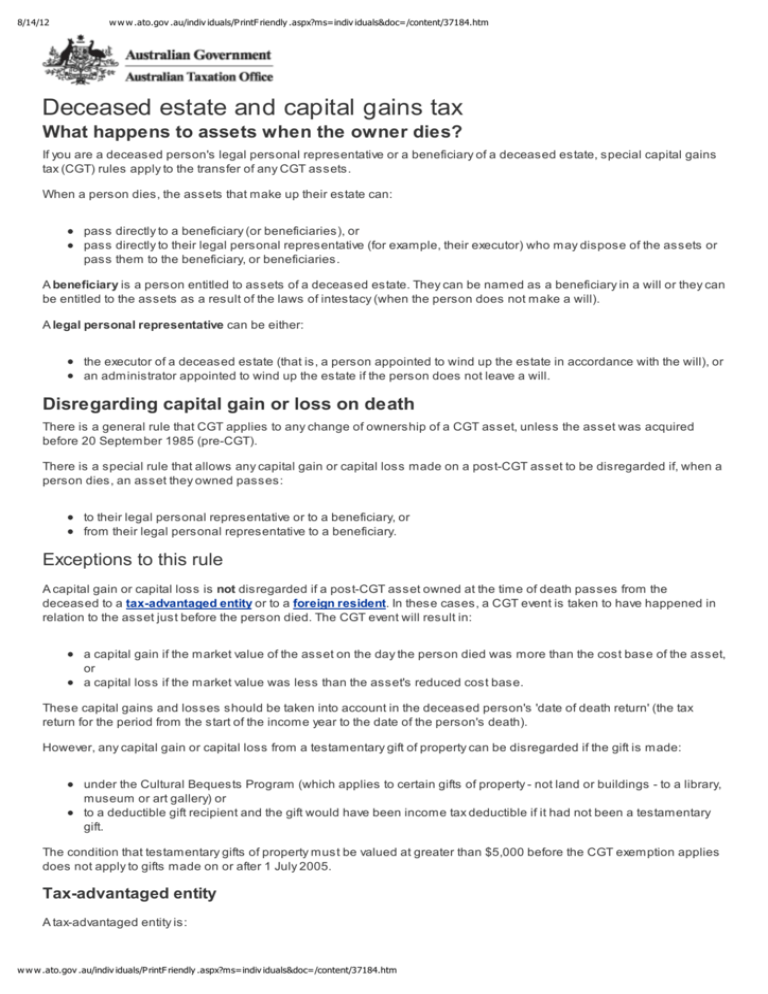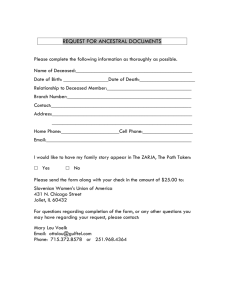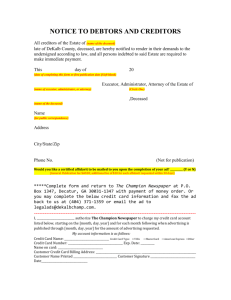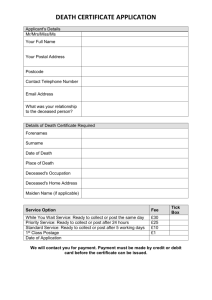
8/14/12
w w w .ato.gov .au/indiv iduals/P rintF riendly .aspx?ms=indiv iduals&doc=/content/37184.htm
Deceased estate and capital gains tax
What happens to assets when the owner dies?
If you are a deceased person's legal personal representative or a beneficiary of a deceased estate, special capital gains
tax (CGT) rules apply to the transfer of any CGT assets.
When a person dies, the assets that make up their estate can:
pass directly to a beneficiary (or beneficiaries), or
pass directly to their legal personal representative (for example, their executor) who may dispose of the assets or
pass them to the beneficiary, or beneficiaries.
A beneficiary is a person entitled to assets of a deceased estate. They can be named as a beneficiary in a will or they can
be entitled to the assets as a result of the laws of intestacy (when the person does not make a will).
A legal personal representative can be either:
the executor of a deceased estate (that is, a person appointed to wind up the estate in accordance with the will), or
an administrator appointed to wind up the estate if the person does not leave a will.
Disregarding capital gain or loss on death
There is a general rule that CGT applies to any change of ownership of a CGT asset, unless the asset was acquired
before 20 September 1985 (pre-CGT).
There is a special rule that allows any capital gain or capital loss made on a post-CGT asset to be disregarded if, when a
person dies, an asset they owned passes:
to their legal personal representative or to a beneficiary, or
from their legal personal representative to a beneficiary.
Exceptions to this rule
A capital gain or capital loss is not disregarded if a post-CGT asset owned at the time of death passes from the
deceased to a tax-advantaged entity or to a foreign resident. In these cases, a CGT event is taken to have happened in
relation to the asset just before the person died. The CGT event will result in:
a capital gain if the market value of the asset on the day the person died was more than the cost base of the asset,
or
a capital loss if the market value was less than the asset's reduced cost base.
These capital gains and losses should be taken into account in the deceased person's 'date of death return' (the tax
return for the period from the start of the income year to the date of the person's death).
However, any capital gain or capital loss from a testamentary gift of property can be disregarded if the gift is made:
under the Cultural Bequests Program (which applies to certain gifts of property - not land or buildings - to a library,
museum or art gallery) or
to a deductible gift recipient and the gift would have been income tax deductible if it had not been a testamentary
gift.
The condition that testamentary gifts of property must be valued at greater than $5,000 before the CGT exemption applies
does not apply to gifts made on or after 1 July 2005.
Tax-advantaged entity
A tax-advantaged entity is:
w w w .ato.gov .au/indiv iduals/P rintF riendly .aspx?ms=indiv iduals&doc=/content/37184.htm
8/14/12
w w w .ato.gov .au/indiv iduals/P rintF riendly .aspx?ms=indiv iduals&doc=/content/37184.htm
a tax-exempt entity (for example, a church or charity), or
the trustee of
a complying superannuation fund
a complying approved deposit fund, or
a pooled superannuation trust.
Foreign resident beneficiary
If a foreign resident is a beneficiary of a deceased's post-CGT asset, any capital gain or capital loss is taken into account
in preparing the deceased person's date of death return if:
the deceased person was an Australian resident when they died, and
the asset is not 'taxable Australian property' in the hands of the beneficiary.
To establish whether or not a person is a foreign resident, see Residency - what you need to know.
Prior year net capital losses
If the deceased had any unapplied net capital losses when they died, these cannot be passed on to you, as the
beneficiary or legal personal representative, for you to offset against any net capital gains.
Winding up a deceased estate
In administering and winding up a deceased estate, a legal personal representative may need to dispose of some or all
of the assets of the estate. Assets disposed of in this way are subject to the normal rules and any capital gain the legal
personal representative makes on the disposal is subject to CGT.
Similarly, it may be necessary for the legal personal representative to acquire an asset - for example, to satisfy a specific
legacy made. Any capital gain or capital loss they make on disposal of that asset to the beneficiary is subject to the
normal CGT rules.
If a beneficiary sells an asset they have inherited, the normal CGT rules also apply.
Date of acquisition
If you acquire an asset owned by a deceased person as their legal personal representative or beneficiary, you are taken to
have acquired the asset on the day the person died. If that was before 20 September 1985, you disregard any capital gain
or capital loss you make from the asset.
Cost base of asset
Assets acquired by the deceased person before 20 September 1985
If the deceased person acquired their asset before 20 September 1985, the first element of your cost base and reduced
cost base (that is, the amount taken to have been paid for the asset) is the market value of the asset on the day the
person died.
If, before they died, a person made a major improvement to a pre-CGT asset on or after 20 September 1985, the
improvement is not treated as a separate asset by the beneficiary or legal personal representative. They are taken to have
acquired a single asset when the person died. The cost base of this asset, when the legal personal representative or
beneficiary acquires it, is equal to the cost base of the major improvement on the day the person died, plus the market
value of the pre-CGT asset on the day the person died, excluding the improvement.
Assets acquired by the deceased person on or after 20 September 1985
If a deceased person acquired their asset on or after 20 September 1985, the first element of your cost base and reduced
cost base is taken to be the deceased person's cost base and reduced cost base of the asset on the day the person died.
If the deceased person died before 21 September 1999 and you choose the indexation method to work out the capital
gain when you dispose of the asset (or when another CGT event happens) you index the first element of the cost base
from the date the deceased person acquired it up until 21 September 1999.
If the deceased person died on or after 21 September 1999, you cannot use the indexation method; and when you
dispose of the asset, you must recalculate the first element of your cost base to leave out any indexation that was included
in the deceased's cost base.
w w w .ato.gov .au/indiv iduals/P rintF riendly .aspx?ms=indiv iduals&doc=/content/37184.htm
8/14/12
w w w .ato.gov .au/indiv iduals/P rintF riendly .aspx?ms=indiv iduals&doc=/content/37184.htm
Note, if you are the trustee of a Special Disability Trust, the first element of your cost base and reduced cost base is the
market value of the asset on the day the person died.
Expenditure incurred by a legal personal representative
As a beneficiary, you can include in your cost base (and reduced cost base) any expenditure the legal personal
representative (for example, the executor) would have been able to include in their cost base if they had sold the asset
instead of distributing it to you. You can include the expenditure on the date they incurred it.
For example, if an executor incurs costs in confirming the validity of the deceased's will, these costs form part of the cost
base of the estate's assets.
Main residence and other real estate
Special rules apply if the asset was the person's main residence.
Even if the property was not the deceased person's main residence, special rules may mean you qualify for a full or part
exemption when you dispose of it.
For details of these rules, see Inheriting a dwelling.
Collectables and personal use assets
A post-CGT collectable or personal-use asset is still treated as such when you receive it as a beneficiary or the legal
personal representative of the estate.
Calculating capital gains tax on assets acquired from a deceased estate
If the deceased died before 11.45am (by legal time in the ACT) on 21 September 1999 and you dispose of a CGT asset
(as beneficiary or legal personal representative) after that time and date, there are two ways of calculating your capital
gain - you can use either the indexation method or the discount method, whichever gives you the better result.
However, the discount method is only available if you are an individual, a trust or a complying superannuation entity.
Elements of the cost base of an asset can be indexed only if you own the asset for at least 12 months before disposing of
it. For the purposes of this 12-month ownership test, you are taken to have acquired the asset when the deceased
acquired it, not from the date of their death.
For the CGT discount to apply, you must have acquired the asset at least 12 months before disposing of it. For the
purposes of this 12-month ownership test, you are taken to have acquired the asset at one of the following times:
for pre-CGT assets - the date the deceased died
for post-CGT assets - the date the deceased acquired it.
Example
Transfer of an asset from the executor to a beneficiary
Maria died on 13 October 2000 leaving two assets - a parcel of 2,000 shares in Bounderby Ltd, and a vacant block
of land. Giovanni was appointed executor of the estate (the legal personal representative).
When the assets are transferred to Giovanni, as legal personal representative, he disregards any capital gain or
capital loss. Giovanni disposes of (sells) the shares to pay Maria's outstanding debts. As the shares are not
transferred to a beneficiary, any capital gain or capital loss on this disposal must be included on the tax return for
Maria's deceased estate.
When all debts and tax have been paid, Giovanni transfers the land to Maria's beneficiary, Antonio, and pays the
conveyancing fee of $5,000. As the land is transferred to a beneficiary, any capital gain or capital loss to date is
disregarded. The first element of Antonio's cost base is taken as Maria's cost base on the date of her death.
Antonio is also entitled to include in his cost base the $5,000 Giovanni spent on the conveyancing.
Example
w w w .ato.gov .au/indiv iduals/P rintF riendly .aspx?ms=indiv iduals&doc=/content/37184.htm
8/14/12
w w w .ato.gov .au/indiv iduals/P rintF riendly .aspx?ms=indiv iduals&doc=/content/37184.htm
Indexation and CGT discount
Leonard acquired a property on 14 November 1998 for $126,000. He died on 6 August 1999, leaving the property
to Gladys. She sold the property on 6 July 2011 for $240,000. The property was not the main residence of either
Leonard or Gladys.
Although Gladys acquired the property on 6 August 1999, for the purpose of determining whether she had owned
the property for at least 12 months she was taken to have acquired it on 14 November 1998 - the day Leonard
acquired it.
At the time of disposal, Gladys had owned the property for more than 12 months. As she is taken to have acquired
it before 11.45am (by legal time in the ACT) on 21 September 1999 and disposed of it after that date, Gladys could
choose to index the cost base. However, if the discount method gave her a better result, she could choose to claim
the CGT discount.
If Gladys chooses the discount method, she would have to exclude from the first element of her cost base the
amount that represented indexation that had accrued to Leonard up until the time he died.
More information
For an overview of capital gains tax, see Introduction to capital gains tax.
For more details on the status of assets you inherited, see Inheriting a dwelling.
For further information about market valuation, read Market valuation for tax purposes.
For help applying this to your own situation, phone 13 28 61.
Last Modified: Thursday, 28 June 2012
Our commitment to you
We are committed to providing you with accurate, consistent and clear information to help you understand your rights and
entitlements and meet your obligations.
If you follow our information and it turns out to be incorrect, or it is misleading and you make a mistake as a result, we will
take that into account when determining what action, if any, we should take.
Some of the information on this website applies to a specific financial year. This is clearly marked. Make sure you have
the information for the right year before making decisions based on that information.
If you feel that our information does not fully cover your circumstances, or you are unsure how it applies to you, contact us
or seek professional advice.
Copyright
© Commonwealth of Australia
This work is copyright. You may download, display, print and reproduce this material in unaltered form only (retaining this
notice) for your personal, non-commercial use or use within your organisation. Apart from any use as permitted under the
Copyright Act 1968, all other rights are reserved.
Requests for further authorisation should be directed to the Commonwealth Copyright Administration, Copyright Law
Branch, Attorney-General’s Department, Robert Garran Offices, National Circuit, BARTON ACT 2600 or posted at
http://www.ag.gov.au/cca.
w w w .ato.gov .au/indiv iduals/P rintF riendly .aspx?ms=indiv iduals&doc=/content/37184.htm






